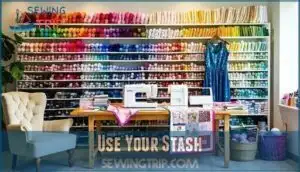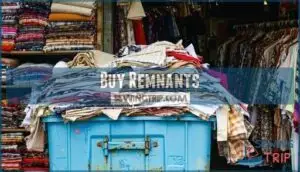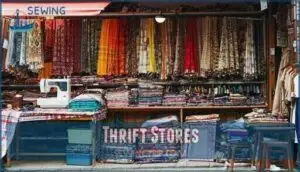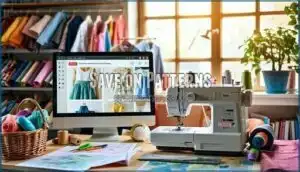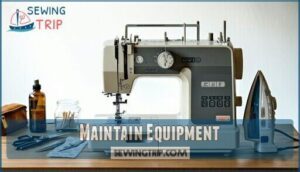This site is supported by our readers. We may earn a commission, at no cost to you, if you purchase through links.

Use free online patterns instead of expensive store-bought ones, and consider buying a reliable used sewing machine rather than splurging on the latest model.
Buy notions like thread, needles, and pins in bulk to slash per-unit costs.
Don’t forget to repurpose old clothes into new projects – it’s like giving your wardrobe a second life while keeping cash in your pocket, and remember that creativity often trumps a hefty budget in the process of making beautiful handmade pieces.
Table Of Contents
Key Takeaways
- Shop your stash first – You will save hundreds by using fabric and notions you already own before buying new materials, turning forgotten supplies into fresh projects.
- Hunt for bargains at thrift stores and remnant bins – You can find quality fabrics, tools, and even sewing machines at 50-70% off retail prices through secondhand shopping.
- Use free online patterns instead of expensive store-bought ones – You will access thousands of free designs and can modify existing patterns to create completely new looks without spending extra.
- Repurpose old clothes into new projects – You will slash fabric costs by transforming worn garments into fresh pieces, salvaging buttons, zippers, and quality fabric for future use.
Is Sewing Expensive?
That sewing machine gathering dust in your closet doesn’t have to drain your wallet to become your creative companion.
Sewing affordability depends largely on your approach—smart project planning and realistic expectations about your skill level make all the difference.
You’ll find that material choices and time investment directly impact your sewing costs, but don’t let sticker shock scare you away.
Starting with cheap sewing projects helps you build confidence without breaking the bank.
Focus on affordable sewing ideas that match your current abilities rather than jumping into complex garments.
Strategic sewing on a budget means prioritizing essential tools first, then gradually expanding your collection.
With thoughtful planning and these sewing cost-saving strategies, you’ll discover that this rewarding hobby doesn’t require a fortune to master.
Consider that second-hand machines offer a budget-friendly start.
Save on Fabric and Notions
Fabric and notions can eat up your sewing budget faster than a hungry serger devours thread.
You’ll slash these costs by shopping your own stash first, hunting for remnants, and exploring thrift stores for hidden fabric treasures.
Use Your Stash
Your fabric stash is your secret weapon for sewing savings tips and staying within budget.
Before shopping, organize your stash by color and fabric type—you’ll discover forgotten treasures perfect for new projects.
Challenge yourself to sew exclusively from your collection for a month. This stash challenge reveals creative fabric combinations you’d never consider otherwise.
- Create a simple inventory system using photos or lists to track what you own, preventing duplicate purchases and inspiring fresh project planning ideas for your frugal sewing hacks.
This approach will help you make the most of your fabric stash and stay on track with your budget.
Buy Remnants
Smart shoppers know that remnant bins are goldmines for sewing savings tips. These leftover fabric pieces offer incredible cost savings—often 50% off regular prices.
Check remnant sizes carefully; they’re perfect for smaller projects like accessories, children’s clothes, or testing patterns. Different fabric types appear regularly, from cotton to wool blends.
You’ll find discount fabric online and at local stores. It’s easy to buy fabric remnants from various online retailers.
Store your fabric scraps in labeled bins by color or weight. While remnants work great for many projects, consider project suitability before buying. That gorgeous silk mightn’t suit your beginner skill level, but it’s perfect for future growth.
Thrift Stores
Your local thrift stores are goldmines for sewing on a budget.
These treasure troves offer incredible deals on materials you’d pay premium prices for elsewhere. You’ll discover unique thrift store fabrics, secondhand machines in excellent condition, and discounted notions that add character to your projects.
Here’s what to hunt for:
- Resale fabrics from bed linens, curtains, and tablecloths – perfect for muslins
- Used sewing tools like scissors, measuring tapes, and rotary cutters
- Secondhand machines from reputable brands at fraction of retail cost
- Cheap fabric sources including vintage patterns and specialty threads
Smart thrifting transforms sewing material deals into exciting adventures while keeping your wallet happy.
Save on Patterns
Patterns don’t have to break your budget when you know where to look for deals.
You can find thousands of free patterns online and transform your existing ones into completely new designs.
Use Free Patterns
Why pay full price when free patterns are everywhere?
Online resources offer thousands of free sewing tutorials and patterns from generous designers.
Try tester patterns where you test new designs before release. Hack patterns by modifying existing ones for fresh looks.
Join pattern swapping groups to trade with fellow sewists. Download PDF patterns from blogs and websites for instant access.
These pattern drafting alternatives keep your wallet happy while expanding your sewing skills.
Alter Existing Patterns
Instead of buying new patterns constantly, you can transform existing ones through clever pattern alteration techniques.
Pattern mashups let you combine different designs—try pairing a favorite bodice with new sleeves or mixing necklines.
Digital alterations make fit adjustments simple using tracing paper to preserve originals, and style modifications like changing hemlines or adding pockets create fresh looks from old patterns.
These combining patterns strategies stretch your budget while building sewing skills, and fabric scraps work perfectly for testing alterations before cutting into good material, making thrifty sewing projects both creative and cost-effective, with a focus on clever techniques.
Save on Tools and Machines
You don’t need to break the bank to build a well-equipped sewing room.
Smart shopping for used tools and proper maintenance can slash your equipment costs by 50-70% while keeping everything running smoothly for years.
Buy Used
Buying used sewing equipment can slash your costs by 50-70% compared to new purchases. You’ll find incredible deals on quality gear that’s already proven its worth.
Smart secondhand shopping transforms your sewing budget:
- Used Machines from Online Marketplaces – Check Facebook Marketplace and Craigslist for vintage Singers and modern computerized models at garage sale prices
- Thrift Store Notions Hunt – Score buttons, zippers, and threads for pennies while supporting local charities
- Secondhand Fabrics Discovery – Find designer remnants and bolt ends that retailers couldn’t move
- Used Equipment Goldmine – Grab professional scissors, rotary cutters, and cutting mats from quilters upgrading their tools
Thrifting sewing supplies feels like treasure hunting – you never know when you’ll stumble upon that perfect vintage button collection or barely-used serger. Take a knowledgeable friend when evaluating secondhand machines to avoid costly mistakes.
When purchasing, consider checking used sewing machines for the best options.
Maintain Equipment
Your sewing machine deserves better than neglect—it’s the workhorse that brings your creative visions to life.
Regular sewing machine care, including equipment cleaning and needle maintenance, can extend your machine’s lifespan by years. Clean lint from the bobbin area after every few projects, oil moving parts monthly, and replace dull needles frequently.
Don’t forget tool maintenance either: sharpen scissors annually, clean your iron’s soleplate regularly, and store tools properly. Quality equipment maintenance prevents costly repairs and keeps your used equipment running smoothly.
A well-maintained machine is a reliable creative partner. By following a routine of preventive maintenance, you can guarantee your sewing machine operates efficiently and effectively.
Earn Money While Sewing
Who says your sewing hobby can’t pay for itself? Turn your skills into income by selling finished projects or earning cash back on your purchases.
Sell Your Creations
Beyond maintaining your tools properly, turning your hobby into a revenue stream can substantially offset your sewing expenses.
You can sell creations through online markets like Etsy or Facebook Marketplace, where millions of shoppers browse daily. Pricing strategies should factor in materials, time, and market rates while remaining competitive.
Utilizing proper sewing patterns is essential for creating sellable items, which involves understanding various sewing techniques.
Consider these selling tips for success:
- Start with craft fairs to test customer engagement and gather feedback on your work
- Use social media marketing strategies to showcase your creations and build a following
- Focus on popular items like bags, home décor, or children’s clothing that sell consistently
Remember, even earning $20-50 monthly helps fund your next fabric haul!
Cash Back Programs
Cashback programs turn your sewing purchases into future savings opportunities. These rewards apps let you earn money back on fabric, notions, and tools from major retailers like Joann and Michaels.
- Download cashback apps like Ebates or Ibotta for automatic savings tracking
- Stack coupon codes with cashback programs for maximum discount programs benefits
- Use referral fees by inviting sewing friends to earn bonus rewards
- Redeem earnings through cashback sites for PayPal transfers or gift cards
Smart sewists can earn $75+ yearly through strategic cashback apps usage. By learning about sewing income benefits, individuals can make informed decisions to maximize their earnings and turn their hobby into a more rewarding experience.
Tips to Stretch Your Budget
Smart budget management combines creativity with careful planning to maximize your sewing potential. These final strategies will help you stretch every dollar while building skills that save money long-term.
Repurpose and Upcycle
Transforming forgotten fabrics into fresh projects can slash your sewing costs dramatically. Instead of tossing old clothing, embrace fabric recycling by turning worn garments into new treasures.
Repurpose clothes by salvaging buttons, zippers, and quality fabric pieces for creative reuse.
| Item Type | What to Salvage | New Project Ideas |
|---|---|---|
| Old Sweaters | Quality knit fabric | Pillows, mittens, scarves |
| Worn Shirts | Buttons, collar stays | Bag linings, pocket details |
| Damaged Jeans | Sturdy denim, hardware | Aprons, tool belts, patches |
Sustainable sewing through upcycled textiles means your wallet stays happy while reducing waste. Refashioning transforms one person’s castoff into your next masterpiece – it’s like treasure hunting in your own closet!
By applying creative upcycling techniques, you can breathe new life into discarded materials and create unique items for your home and wardrobe.
Use Expensive Materials Sparingly
You don’t need to blow your budget on luxury fabric for every project.
Smart shopping involves using expensive materials strategically—reserve silk, velvet, or designer textiles for collars, cuffs, or focal points rather than entire garments.
This budget cutting approach delivers 80% of the luxury look while slashing costs by 60%.
Material substitution works wonders too.
Combine premium scraps with economical cotton for stunning results.
Frugal crafting means making every yard count through careful planning and strategic placement of those pricey elements.
Frequently Asked Questions (FAQs)
How can I save money on sewing?
Thread your way to savings like a smart seamster! Shop thrift stores for quality fabrics, repurpose old clothes, use free online patterns, and swap materials with fellow sewers.
Can you sew on a budget?
You can create beautiful projects without breaking the bank.
Shop thrift stores for quality fabrics, repurpose old clothing, use free patterns online, and swap materials with fellow sewists to stretch every dollar.
How do I save money on sewing tools and notions?
Buy bulk notions online, shop thrift stores for buttons and zippers, borrow specialty tools from friends, and hunt end-of-bolt fabric sales for maximum savings.
How can a sewist save money?
You’ll slash sewing costs by shopping your stash first, hunting thrift stores for quality fabrics, and repurposing old clothes into new projects—it’s like treasure hunting with scissors!
Do you have a stash for sewing on a budget?
Like a treasure chest waiting to be discovered, your fabric stash becomes your money-saving superpower.
You’ll collect remnants, thrift finds, and leftover materials over time.
Smart stash-building means shopping sales strategically and repurposing old garments into fresh fabric.
How can I refresh my sewing collection without spending money?
Organize and refresh your existing materials first.
Sort through fabric scraps, unfinished projects, and old clothes you can repurpose.
Transform sweaters into pillow covers, salvage buttons and zippers, and turn bedsheets into practice garments for new techniques, which can help you repurpose old items.
How to save money with sewing?
You’ll slash fabric costs by shopping thrift stores, repurposing old clothes, and using scraps creatively.
Make your own bias tape, share patterns with friends, and hunt for sales to stretch every dollar further.
What is the easiest way to save money?
Your wallet’s best friend isn’t cutting coupons—it’s sewing from your existing stash.
You’ll slash spending by repurposing old clothes, using fabric scraps, and borrowing patterns instead of buying new materials constantly.
How can I organize my sewing space efficiently?
Transform your sewing room by grouping similar items together in clear containers.
Use vertical storage like pegboards for tools and thread racks for spools.
Keep frequently used supplies within arm’s reach of your machine for smooth workflow, utilizing vertical storage to optimize your space.
Whats the best way to store fabric properly?
Store fabric rolled on tubes or folded neatly in clear bins. Keep it away from direct sunlight and moisture. Label everything so you’ll actually find what you need later.
Conclusion
Smart sewers know that a single yard of premium fabric can cost more than an entire thrift store outfit – but that doesn’t mean you need deep pockets to create stunning pieces.
Learning how to save money on sewing transforms your hobby from budget-buster to smart investment. You’ve discovered fifteen proven strategies that’ll keep your wallet happy while your creativity soars.
Start with one or two tips, then gradually build your money-saving toolkit. Remember, the most beautiful handmade pieces often come from clever resourcefulness, not expensive materials, and can lead to a stunning pieces creation.

